Malcolm R. Campbell's Blog, page 199
October 28, 2015
Keeping those sequels consistent
At a book signing for his award-winning novel A Distant Flame, Philip Lee Williams told us that before he started worked on the manuscript, he created a timeline showing where everyone was at every moment as Union troops approached Atlanta. I told him my wife was going to hear about that because she thinks I’m overly picky about research. He said a lot of people’s eyes glazed over at the thought of such a timeline.
 I’ve been reading Diana Gabaldon’s “Outlander Series” ever since the first book appeared in 1991. I’m reading Written in My Own Heart’s Blood (2014) now. I doubt she outlined all of the English, Scots, and American history her series has covered leading up to the current novel set during the American revolution.
I’ve been reading Diana Gabaldon’s “Outlander Series” ever since the first book appeared in 1991. I’m reading Written in My Own Heart’s Blood (2014) now. I doubt she outlined all of the English, Scots, and American history her series has covered leading up to the current novel set during the American revolution.
But her large, 800-page books are remarkably detailed and have a large cast of characters on multiple timelines. I wonder how she keeps it all straight. I wonder if Williams would have to re-read A Distant Flame in addition to his Civil War timeline if he wrote a sequel.
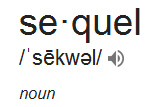 Readers–like Star Trek fans–are always the first to catch inconsistencies the author and his/her editors missed. A minor character’s eyes change color between books or episodes, a battle fought one year is suddenly at a different time and place, a person who said he didn’t know the main character turns out to have met them dozens of times in earlier books.
Readers–like Star Trek fans–are always the first to catch inconsistencies the author and his/her editors missed. A minor character’s eyes change color between books or episodes, a battle fought one year is suddenly at a different time and place, a person who said he didn’t know the main character turns out to have met them dozens of times in earlier books.
I’m an intuitive writer. That means I never outline anything and don’t know before writing a scene how it’s going to end. I’ve had a good editor and she sees things I miss. But she can’t fix major goofs. I worried about making Sarabande consistent with The Sun Singer. And now, as I work on a sequel to Conjure Woman’s Cat, I’m amazed at how often I have to go back and check things to make sure the new book isn’t out of sync with the earlier book.
This is the only time I wish I were disciplined enough to write an outline. Truth be told, I sort of cheated in English classes where we were expected to turn in both the outline and the term paper because I always wrote the outline after the paper was done. I suppose I can do now, but my eyes glaze over at the thought.
It’s strange re-reading ones own work. I come across passages that I’m surprised that I was able to write. Other passages, I wish I’d handled slightly differently. And I marvel at how my detail-oriented mind will consider the growing seasons of plants the characters see while hiking through the woods, but cannot remember who they were hiking with.
Of course, if you’re submitting to major publishers and agents, they’re going to require a synopsis. I’ve written those several times and have to confess that having them later on as reference does help keep sequels consistent. Some writers make character lists and spend a great deal of time writing little character studies about them that include height, weight, eye color, hair color, and other details. If I did that, I wouldn’t have to search through my previous books using terms like “hair” or “eyes” to see what color I chose.
It’s not that that stuff doesn’t matter. It does. It’s an important part of making the character and his/her actions seem real and valid. Nobody ever accused me of having an encyclopedic mind. I’m horrible at Scrabble, Jeopardy and Trivial Pursuit. I think it all goes back to a college geology course in which the teacher said, in this class we don’t memorize things for tests; instead, we talk about larger concepts because anyone with a good set of reference books can look up the details.
That was my new mantra. Never again would I consider listing all the battles of a war and memorizing the dates they happened–much less all the characters in one of my books and the colors of their eyes, hair and favorite shirts and blouses.
While, I love writing without an outline, it plays hell with keeping all the facts straight when it’s time to write a sequel. Yes, I know, I can forget writing sequels. Unfortunately, I like the characters too much and can easily think of more stories to tell about them.
If you write, how do you keep your characters straight from book to book to book. If you read novels in a series, do you catch yourself going back to earlier books because you think the author has gotten something backwards?
Since I write magical realism, fantasy and paranormal stories, I’m ready for any reader who finds any inconsistency. “Hey, Dude, it’s magic.”
–Malcolm
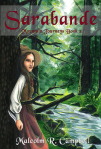 Malcolm R. Campbell is the author of “Sarabande,” a contemporary fantasy coming out in a new edition from Thomas-Jacob Publishing on November 1. You can pre-order the Kindle edition now.
Malcolm R. Campbell is the author of “Sarabande,” a contemporary fantasy coming out in a new edition from Thomas-Jacob Publishing on November 1. You can pre-order the Kindle edition now.


October 27, 2015
In remembrance of things past: stuff that’s gone with the wind
“I felt once more how simple and frugal a thing is happiness: a glass of wine, a roast chestnut, a wretched little brazier, the sound of the sea. Nothing else.”
― Nikos Kazantzakis, Zorba the Greek
I miss lots of things. Some day, you will, too. You’ll tell your children and others who are forced to listen to your nostalgia about the best of what you had and how nobody cares about it any more.
In no particular order, here’s today’s remembrance of things past:
 Being allowed to purchase paregoric and codeine over the counter at a drug store.
Being allowed to purchase paregoric and codeine over the counter at a drug store.Endive (escarole) and watercress in grocery store produce departments.
A smaller federal government.
A society that didn’t expect parents to monitor their kids’ activities 24/7 and actually allowed them to walk or ride bikes to school.
People who came over to dinner who talked to me around the table rather than talking and texting with people who weren’t there.
Family doctors who actually treated things rather than sending everyone off to see a specialist who charged a whole lot more money to tell you what you already knew.
Bubble gum with baseball cards.
 Baseball before it had a playoff system prior to the World Series.
Baseball before it had a playoff system prior to the World Series.Weddings that didn’t cost $25,000 to $50,000.
A dial tone.
Coffee in a one-pound can or sack.
Woolworth’s, McCrory Stores, A&P, Foremost Milk, and Grapette.
Neighborhoods where people didn’t own automatic weapons for whatever reasons they own them now.
Vent windows in cars.
 The Atlantic when it was called The Atlantic Monthly and published fiction and poetry rather than being a quasi-political magazine.
The Atlantic when it was called The Atlantic Monthly and published fiction and poetry rather than being a quasi-political magazine.Book review sections in most major newspapers.
Reporters who didn’t find ways to get their personal opinions into their stories.
The Hardy Boys.
Cameras that used film.
Young people who didn’t expect to have (right out of college) the kinds of houses, cars and furnishings their parents took a lifetime of hard work to acquire.
Christmas decorations that weren’t put out before Thanksgiving and weren’t thrown out before nightfall on December 25th.
A restaurant entrée that included meat, several vegetable side dishes and a salad rather that a slice of nearly raw meat perched on top of sautéd greens and a swipe of colorful sauce across the plate prepared by a food stylist.
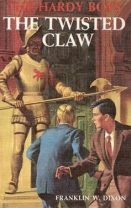 Playing outside with old toys and a lot of dirt.
Playing outside with old toys and a lot of dirt.Clean rivers.
Multiple varieties of U.S.-grown apples.
Stuff in stores that wasn’t encased in hard-to-remove clear plastic.
Route 66.
Airports without TSA.
Seeing a movie in a theater for $1.00.
Buying a candy bar for 50₵
Having a ₵ sign on my keyboard.
Silver dollars and $2 bills.
Catalogue, Hallowe’en and Doughnut rather than Catalog, Halloween and Donut.
Getting a margarita without an act of Congress to have it served without ice, without goofy flavorings and with salt around the rim of the glass.
A wedge of lettuce with thousand island dressing with the blue plate special at the lunch counter.
City streets before texting.
Gas stations where the attendant pumped the gasoline, washed the windows, checked the oil and water, and swept the car floors with a whisk broom.
A Walmart-free town.
–Malcolm


October 23, 2015
‘Time let me play and be Golden in the mercy of his means’
“Other than childhood, what was there in those days that is not here today?”
–St.-John Perse
The past is a bittersweet smorgasbord of delights that are forever new in a writer’s memory rather like Dylan Thomas’ “Fern Hill” where he was “green and carefree” and “famous among the barns.”

Canopy road en route to the farm – Leon County (FL) Public Works photo
My Fern Hill was owned by Mr. Henry who arrived at my best friend’s house around the corner and drove everyone who wanted to go out to his farm for a morning of unfettered play. The woods and the fields were ours for the day, all because Mr. Henry wanted to do something for others, as a debt he owed the doctor–my best friend’s father–who saved his life.
We worked, too. We stacked bales of hay in an old lime house, helped build fences, fought an occasional grass fire, moved cattle from one field to another, cleaned up stuff that didn’t belong where it got left. Every Saturday ended with a line of beer cans on a row of fence posts behind the house where each boy held a .22 rifle and five .22 shorts. “Fire when ready.” And we did.
One day I went off to college and never saw Mr. Henry again. Another day, I heard that he had passed away. He was one of those teachers who didn’t know he was a teacher, and his lessons have long survived him and perhaps most of those who were for a few short years “young and easy under the apple boughs.”
I don’t remember truly thanking him for what he did other than telling him we had had a great time when he brought us back to town. If spirits read the verse of those of us who are still here with our memories, perhaps he found this poem of mine published several years ago.
Debt, Paid in Full
Without fail at first light,
the old Ford materialized on Saturday mornings
to carry us out the canopy road to Mister Henry’s farm.
When Doctor Smith saved Mister Henry’s life,
his patient saw within that unexpected miracle a living,
breathing obligation to be repaid with time and space.
While Mister Henry had reason to believe
one’s days are numbered, he knew the doctor’s children
and children’s friends perceived an infinity of time on their hands.
We took for granted our Saturdays would never end
and loosely defined our mornings with minnows and tadpoles
in the branch trickling through the sweet Southern woods.
We presumed all fences were made for climbing,
claiming all fields and building infinite afternoons with bales o hay
stacked high in the lime house en route to heaven.
We blended work and play on those magical acres,
carrying home tall tales of our grand adventures as talismans
to protect us from the world outside our dreams.
Within the immortality of youth, we saw little threat
from the bull in the field, the copperheads in the woods
or the eventual day when the Ford would not appear.
Without fail or sufficient thanks at last light,
childhood and Mister Henry’s farm slipped into the night
before we knew the debt was more than right.
from Forever friends, edited by Shelagh Watkins, 2011
–Malcolm
Website for my Florida novella “Conjure Woman’s Cat”


October 21, 2015
Does anyone remember this astral projection exercise?
When I was in high school, I bought a book that purported to teach a variety of psychic techniques. Unfortunately, I no longer remember the name of the book or what happened to it.
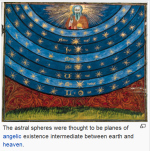
Wikipedia photo
The book included an astral projection exercise far different than the usual ones which suggest lying down, meditating and ultimately visualizing oneself floating above the bed.
Here’s what I remember about it:
Sit in a comfortable chair and relax at a time when nobody else is home.
Stand up and walk to some other location in the house noting what you see along the way.
Return to the chair.
Close your eyes and visualize taking that same walk through the house, seeing in your mind’s eye what you saw when you physically walked through the house. Remember any smells, textures, lights and shadows, etc. as specifically as you can.
Visualize returning to the chair.
Now, open your eyes and physically walk through the house again by the same route and return to the chair.
Next, visualize taking that walk through the house.
According to the book, you will sooner or later return to the chair and find yourself already sitting there. Supposedly when this happens, you will be in your astral body and can experiment with willing yourself to appear in one room or another and, in time, at other places.
I tried this exercise several times, but never made many physical or mental walks through the house because the longer I did it, the more I began to dread that it would work. Why this exercise bothered me, I’m not sure. Maybe it was the loss of control, the idea that I would just stumble across myself rather than lifting away from myself in a controlled way.
Has anyone ever heard of this, much less tried it? If so, did it work?
This is a curiosity question because something about this exercise has always bothered me. I wish I could track it down and read the instructions and rationale again to see why I felt panic rather than curiosity about it.
–Malcolm
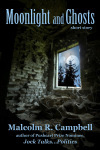 As you might expect, Malcolm R. Campbell is the author of books and stories in the paranormal, magical realism and fantasy genres, including “Moonlight and Ghosts.”
As you might expect, Malcolm R. Campbell is the author of books and stories in the paranormal, magical realism and fantasy genres, including “Moonlight and Ghosts.”


October 18, 2015
Review: ‘The Way of Spirit’ by Joanne Helfrich
The Way of Spirit: Teachings of Rose, Joanne Helfrich (NewWorldView December 7, 2014), 218pp.
The publisher of The Way of Spirit says this spiritual self-help book will help you discover your life’s purpose and the means of achieving your soul’s deepest fulfillment. Whether or not the book is successful in doing that depends on the reader’s point of view about who Rose is and how Joanne Helfrich received Rose’s guidance.
 Helfrich describes Rose as “an energy personality essence–a multidimensional being who exists primarily outside out physical world of space and time.” Her guidance was received by an energy exchange method of meditation more commonly known as channeling.
Helfrich describes Rose as “an energy personality essence–a multidimensional being who exists primarily outside out physical world of space and time.” Her guidance was received by an energy exchange method of meditation more commonly known as channeling.
Jane Roberts’ popular Seth books of the 1970s introduced the general public to energy personalities, channeling, and a body of metaphysical information summed up by the phrase “you create your own reality.” Helfrich’s book complements Seth’s teachings.
While many readers intuitively felt that Seth’s non-mainstream, impossible-to-prove view of reality was correct, they often had trouble putting his concepts into actual practice in their lives. Subsequently, teachers such as Lynda Dahl (Seth Talk) and channelers such as Vicki Pendley (Elias) and Serge Grandbois (Kris) have explained and/or added to the information Jane Roberts provided via 1,500 trance sessions between 1963 and 1984.
Practical Approach
Helfrich has written a joyful and very practical guidebook for those seeking “big picture” knowledge and personal transformation. Students of Seth will find some overlap here between the concepts in The Way of Spirit and those they already know. Others are likely to become enchanted by Rose’s positive, no-nonsense approach to who you are and what you can accomplish.

Original Seth book – click on cover for current edition
Unlike some of the “Law of Attraction” books that focused on acquiring fame, fortune and other material world gains, The Way of the Spirit focuses on inner transformation and a compassionate approach to others. Rose sets the tone for the book by saying, “Since you create all of your reality, it stands to reason that when you become heroes pf your own lives, you change yourself and your world for the better.” The approach echoes Joseph Campbell’s (The Hero With a Thousand Faces) admonition that you cannot have a positive impact on the world until you “fix” yourself first.
Rose focuses on the individual: discover who you are, find your purpose and the bedrock intention of your life, own your own reality, interact with others with love and compassion, and understand that transformation comes from alignment with the universe, not by using brute force logic or pushing others aside to get what you desire.
Naysayers will be quick to point out that, like many other spiritual books focused on meeting goals and desires, this book says you don’t automatically get what you want; you get what the universe thinks you need. Many see this fact as a “kings-X” rule that negates of the rest of the books, allowing the authors to say, “well, your law of attraction meditation didn’t work, not because the system is flawed, but because you were trying to attract what you weren’t supposed to have.”
That point is well taken and the “mechanics” of whether or not the workings of “you create your own reality” should be interpreted as “you create your own reality when the universe consents.”
Quite clearly, The Way of the Spirit is about the way of the spirit, not the way of the transitory, illusory physical world of success and failure, rich and poor, or fame and anonymity.

Helfrich – click on photo for author’s web site
One strength of this positive and enchanting book is the section called practices. These are not recipes or A-to-Z formulas for making reality (or yourself) change before your eyes. As Rose explains it, “Practices are small, regular actions that help you live a happier life. They may be things you already do, but wish to do in a different way. When they become habits, they will transform your life.” These practices are:
Access Alternatives – Breaking away from closed thinking patterns
Intent Practices – Discovering and expressing your inate abilities
Souter – Finding a new way to visualize your breathing
Rest in Rose – Finding ways to relax and experience ones essence
IDEA – Discovering your foundation beliefs and their alternatives
Addressing Fears – Learning the role of fear and an appropriate response to it
Vespers – Meditating and exploring ways to channel your essence in day ahead
Evening Prayers – Calming your mind and staying connected as you fall asleep
The Way of the Spirit–like Jane Roberts’ Seth books–presents a vastly different view of reality than we are taught in school. Everything we “know” about time and space, physical reality, and cause and effect is challenged here. It’s a lot too take in and it cannot be taken in with an effortless leap of faith no matter how right it sounds in the reading of it.
Joanne Helfrich has created a thought-provoking approach to making things better in our lives. The practice sections give us a way to test drive her ideas without having to throw away the world view that has sustained us for better or worse up to now. This inspirational book is highly recommended.
Malcolm R. Campbell is the author of contemporary fantasy and magical realism novels and short stories that focus on characters making transformational journeys.


October 17, 2015
The textures of old buildings
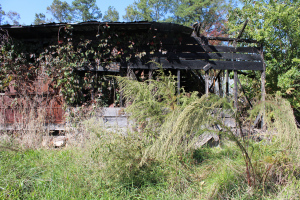
Fire damage is clearly evident on this end of the building.
When we moved in January to a new house on a corner of the farm where my wife grew up, we ended up with a variety of outbuildings that had had minimal use for years. We’re using the old garage for our riding mower and other lawn tools. Since it sits near our house, we had the old smokehouse restored. So far, we haven’t decided what to do with the old chicken house.
Ten years ago, a fire destroyed two other buildings and damaged the chicken house. Except for wandering free-range chickens (if any), a chicken hasn’t been in there for ages. My wife’s folks stored hay in the building before the barn was built. Since her dad was a contractor, the building became a convenient place to store lumber left over from one job or another.
As the pictures show, Mother Nature keeps an eye on abandoned buildings, waiting for an opportunity to reclaim them for wild

Vines do their work slowly, but thoroughly.
things, nature spirits and haints. We had’t gone inside this building since we moved here. Well, obviously any rehab of the building is going to have to start with a lot of clearing away around the outside. Once we get fences put in, we’re probably going to get a few goats.
Could one end of the building be turned into a shelter for them? Maybe. Could some of it be used for storage. If so, we might be able to put the tractor in there. Right now, it’s taking up half of the old garage which sits much closer to the house. The tractor hasn’t been cranked up since last year; it needs a new bush hog if we’re ever going to use it for some of the grass that we’re currently mowing with the riding mower.
On the plus side, there’s probably enough lumber stored inside the building to rehab the building. We might need some more tin, though. (No, we’re not going with a copper roof in one of the colors currently in vogue in subdivisions.) Well weathered tin and old one-by-sixes are part of the textured charm of old buildings. More often than not, buildings like these were never painted. You don’t see a lot of “barn red” around here.

This lumber will keep us from spending a fortune at Home Depot.
When I served as the chairman of a historic preservation commission in the small town where we used to live, our group championed the cause of adaptive re-use. Our old cotton mill, for example, had been converted into a world of shops. This preserved the old building and also the character of the town. Atlanta has had some success preserving old brick factory buildings and using them for loft apartments.
We don’t need (or want) a chicken house. While a very conservative preservationist might tell us to make the building a chicken house again even if we never bought any chickens, there’s no evolution in that. We can adapt. For one thing, if we made it a chicken house, it would sit unused rather like a museum display. Nature would start working on it around the door frames and the gaps in between the shiny new sheets of tin. For another thing, having a ready-to-use chicken house sitting there is probably unlikely to help us resell the property some years down the road.
Idly, I wonder what we’ll do with the leftover lumber. That’s not a big concern, because I think it will find its way somewhere, a place where it will keep its texture while serving a brand new purpose–like any old building or retired person.
–Malcolm
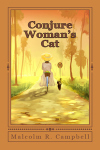 Malcolm R. Campbell is the author of the Pushcart Prize nominated “Conjure Woman’s Cat,” magical realism set in the Jim Crow era of Florida. A conjure woman ends up battling the local KKK with folk magic and, as the title suggests, the help of her cat.
Malcolm R. Campbell is the author of the Pushcart Prize nominated “Conjure Woman’s Cat,” magical realism set in the Jim Crow era of Florida. A conjure woman ends up battling the local KKK with folk magic and, as the title suggests, the help of her cat.


October 10, 2015
Don’t push the envelope, destroy it
Push the Envelope: To attempt to extend the current limits of performance. To innovate, or go beyond commonly accepted boundaries.
As The Phrase Finder site reminds us, “pushing the envelope”–prior to Tom Wolfe’s 1979 book The Right Stuff–was a concept used primarily by mathematicians and engineers, including those exploring the idea of space travel. Since then, the phrase has come into general use to mean going beyond the usual ways of doing things.
 As a writer, I focus on characters who either believe they are powerless and/or who seem to be powerless based on society’s perception of them.
As a writer, I focus on characters who either believe they are powerless and/or who seem to be powerless based on society’s perception of them.
If you have read my novels The Sun Singer, Sarabande, and Conjure Woman’s Cat, you have seen a common theme: protagonists in seemingly impossible circumstances who must go beyond the usual ways of doing things to survive.
The envelope, like the box, is a comfortable place. It contains our successes of the past and what we’ve learned from them. It’s risky to push it, much less destroy it. The envelope, like the box, is also a prison, cozy as it may be.
To change our situations and ourselves, we often have to destroy the envelope to get rid of the invisible restraints that keep us from finding power or even a simple solution.

This is a good place for storing stuff. It’s a bad place for thinking.
When Robert Adams destroys the envelope in The Sun Singer by stepping into an alternative universe, he doesn’t know who he is for a while. That’s a “real life” danger, too. But Robert learns and by the end of the novel he is much more than what he was at the beginning.
I’m not sure I would take the risks my characters take, but I can visualize what it might be like by writing my stories. When I read them later, my imagination takes off outside the envelope where I can explore the pros and cons of doing such a thing in my own reality.
My writing has changed me. No, it hasn’t turned me into a Gandalf or a Harry Potter, but it has made me very suspicious of people who say “we’ve always done it this way” and “doing what you ask is impossible.”
 Malcolm R. Campbell is the author of “Sarabande,” a contemporary fantasy coming out in a new second edition for Thomas-Jacob Publishing on November 1. Sarabande, like Robert Adams, must destroy the envelope to escape what has been haunting her.
Malcolm R. Campbell is the author of “Sarabande,” a contemporary fantasy coming out in a new second edition for Thomas-Jacob Publishing on November 1. Sarabande, like Robert Adams, must destroy the envelope to escape what has been haunting her.
If you read on Kindle, you can pre-order your copy today.


October 7, 2015
The black horse in my novels
The Black Horse is both death defying and death seeking. In other words it is symbolic of death and rebirth. It signifies the closing of one door and the opening of a new door. It can also signify the need for you to take a leap of faith and trust what you are being guided to do even if you can’t see the reason or the result. Go blindly forth and believe.
— Spirit Animal Totems and their messages
A black horse in a dream could represent a part of the shadow self or a part of your personality that you usually prefer to keep hidden; instinctual urges operating in the dark recess of your mind; the unknown, what is mysterious.
—Spirit Animals and Animal Totems

Lake Josephine and Mt. Gould where Sarabande first meets Sikimí. – NPS photo
A huge black horse named Sikimí has appeared in five of my novels, including the upcoming new release of Sarabande. In all of these stories, he has been a totem animal associated with the mountains of Glacier National Park, Montana.
The word Sikimí means black horse in the Blackfeet language. The Blackfeet are the long-time residents of the eastern side of Glacier Park and the adjacent plains. They are the people the land knows and their language is the primary language the animals, trees, mountains and forces of nature respond to.
Appropriately, Sikimí appears in what might be called a “journey novel,” in this case, a “heroine’s journey.” Typically, heroines’ journeys are associated with night, the moon, the underworld, and the subconscious mind.
Journey novels often portray both physical travel and shamanistic or internal travel. Horse symbolism is well known whether we find the information in classic books such as Ted Andrews’ Animal Speak or David Abram’s Becoming Animal, online sites like the two quoted at the beginning of this post, or intuit them in our meditations and dreams.
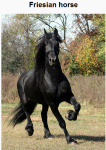
This Wikpedia photo looks like my vision of Sikimí.
I felt immersed into Sarabande’s story as I wrote it because Sikimí, along with Maistó (Raven), is my totem animal. When I meditate–or dream–about travel to places I’m intentionally visualizing, I will be riding Sikimí. Sikimí is, by the way, a huge Friesian horse with the classic (as opposed to “sport”) size and conformation. So it is, that I find it easier and more intuitive using this horse in a novel about a young woman named Sarabande who is going on a journey, not only to another place but another realm.
Sikimí and I are old friends.
Ted Andrews’ associations of the horse with travel, power and freedom work perfectly as symbols throughout the novel. We know these symbols, subconsciously if not consciously. Sikimí is intended to help pull the reader into the story by attuning with the reader’s intuitive knowledge about horses. If the reader likes horses, rides horses, and most especially appreciates the original Gothic (light draft horse) Frieisians, so much the better.
Sarabande quickly bonds with the horse on their first meeting as you see in this snippet:
 Sikimí nodded or seemed to nod, but within his breath she briefly glimpsed the soul of night, a soul as powerful as the broad-chested Friesian of its manifestation, and there were feral love and rage there that far exceeded the scope of her understanding. But within that scope, her heart told her that night in the shape of a horse would carry her to the cornfields of Illinois without trying to chart the destiny of the ride.
Sikimí nodded or seemed to nod, but within his breath she briefly glimpsed the soul of night, a soul as powerful as the broad-chested Friesian of its manifestation, and there were feral love and rage there that far exceeded the scope of her understanding. But within that scope, her heart told her that night in the shape of a horse would carry her to the cornfields of Illinois without trying to chart the destiny of the ride.
What would it be like to ride night in the shape of a horse? I hope readers will wonder about that as they follow Sarabande’s journey from mountains to prairie and back again. I think I know what it’s like, but readers may well have other ideas that will influence how they react to the novel.
Once the novel leaves my computer and a publisher releases on Amazon and other sites, the story is no longer completely mine. Everyone who reads it will, in a sense, be reading their own version of the novel depending, in part, on how the large black horse gets into their thoughts.
–Malcolm
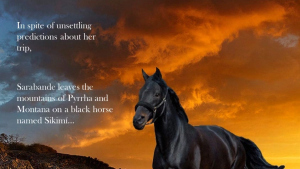
Clear here to see the trailer for “Sarabande.”
The Thomas-Jacob Publishing second edition of Sarabande will be released on November 1, 2015. The Kindle edition is available now on Amazon for pre-order.


October 4, 2015
Briefly Noted: ‘Rosemary: The Hidden Kennedy Daughter’
Rosemary: The Hidden Kennedy Daughter, by Kate Clifford Larson (Houghton Mifflin Harcourt (October 6, 2015), 320pp.
If you remember the era when John F. Kennedy was President, you probably don’t remember his sister Rosemary. There’s a reason for this. The first daughter of Rose and Joseph P. Kennedy, Sr, was confined at 23 to a mental institution in Wisconsin where she would remain until she died at 86 in 2005.

Kennedy – Wikipedia photo
At birth, a nurse held her in the birth canal for two hours while waiting for the doctor, fearing the doctor would lose money if the delivery occurred before he arrived. Potentially deprived of oxygen, she was developmentally disabled. Rose and Joe concealed this, even from her siblings. Her IQ was judged to be a 70. A gorgeous child, she even met Queen Elizabeth and other dignitaries. However, as she grew older, she became rebellious, causing Joe to send her to a hospital for the lobotomy that almost succeeded in turning her into a vegetable.
In a review titled The Saddest Story Ever Told, the Wall Street Journal, calling Larson’s book a “heartbreaking biography,” says while lobotomies did modify behavior, there was no evidence that they cured mental deficiencies. “The American Medical Association warned of its dangers. Nevertheless, Joe went ahead.”
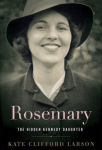 She was left crippled, speechless, and quiet with a substantially lower IQ. As The Wall Street Journal puts it, “The operation had been botched.” That seems to be a contradiction in terms, but nonetheless apt.
She was left crippled, speechless, and quiet with a substantially lower IQ. As The Wall Street Journal puts it, “The operation had been botched.” That seems to be a contradiction in terms, but nonetheless apt.
Larson old NPR, of Rose and Joe, “I have sympathy for their position, but given their wealth, there were other alternatives, and they only had one vision of an alternative, and that was convent schools. And there were alternatives for Rosemary at the time — and he chose this radical, radical choice. At the time, it was still very experimental, so as a father, would he have experimented on his sons? I don’t think so.”
Kirkus calls the book “well researched,” author Will Swift calls it “a poignant story,” and author Marya Hornbacher calls it “an engrossing portrait of Rose and Joe Kennedy’s tragic misunderstanding of their oldest daughter’s capabilities, and of how her fate changed the Kennedy family forever.”
I call it an American tragedy about (as Larson calls her) a “lovely, lovely child, [who] grew to be a lovely adult woman” who was ruined by health care professionals and then hidden by negligent co-conspirators named Rose and Joe.
–Malcolm


October 1, 2015
Thomas-Jacob releases new edition of ‘Sarabande’
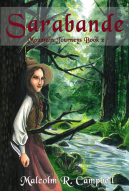 Thomas-Jacob Publishing is releasing a new edition of Sarabande just in time for the 2015 holiday season.
Thomas-Jacob Publishing is releasing a new edition of Sarabande just in time for the 2015 holiday season.
The second book in the “Mountain Journeys” series, the novel sweeps a young woman along a dark and ill-fated trek from the high country of Montana to the prairie of Illinois to escape a ghost. While the novel’s official release date is November 1, the Kindle edition is available for pre-order on Amazon now.
Haunted by her powerful sister Dryad from beyond the grave, Sarabande leaves the world of Pyrrha from its hiding place within Montana’s Glacier Park, and travels on horseback to Illinois to seek the help of Sun Singer Robert Adams. Sarabande almost dies trying to reach him and it’s soon obvious that evil has followed her from the western mountains to Robert’s small town in a world of soybeans, corn, brick streets and old homes.

Click here to see the trailer on YouTube
Robert saved Sarabande’s life in the first book of the series, The Sun Singer. Truth be told, he doesn’t think he can do it again. His magic is weak, all but forgotten. Worse yet, he remembers Dryad’s moon magic and hypnotic voice and fears that he can’t resist her seductive charms another time.
–
Sarabande, a contemporary fantasy, was written so that it can be read as a standalone novel about a woman’s perilous journey. It can also be read as a sequel to The Sun Singer, which was the story of Robert’s journey to Pyrrha. The Sun Singer ended on a positive note, but there were a few loose ends.
–Malcolm
Malcolm R. Campbell is also the author of “Conjure Woman’s Cat,” “Emily’s Stories,” and “Jock Stewart and the Missing Sea of Fire.”





